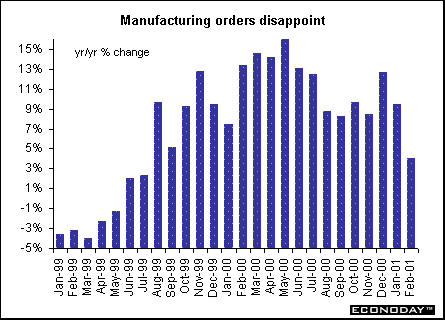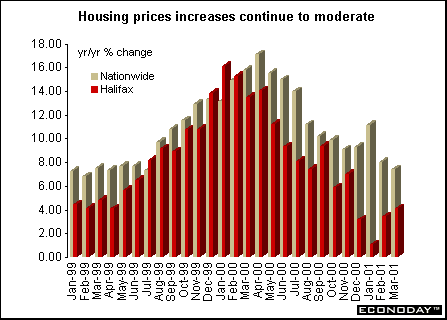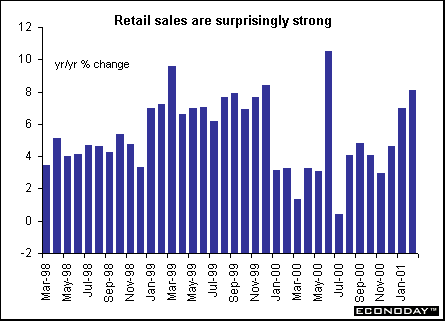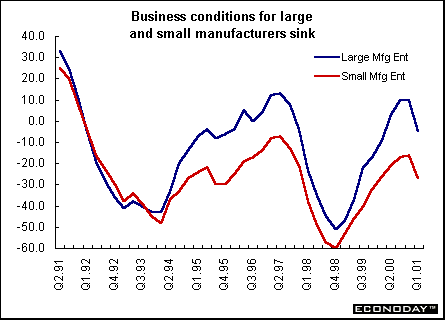
Indicator scoreboard
EMU - March seasonally adjusted Reuters purchasing managers' activity index fell to 51.2. This was the 11th consecutive decline, with the index hitting its lowest level since March 1999 and indicating that the pace of manufacturing sector growth continues to slow. The seasonally adjusted PMI manufacturing activity index is based on data from seven EMU countries. An index level above 50 indicates that the manufacturing sector is expanding, while a level below 50 indicates contraction. The higher the index above 50, the stronger sector growth.

March seasonally adjusted Reuters services activity index fell to 53.4 from 54.4 in February, its lowest level since January 1999. After its peak of 62.2 in April of last year, the index has fallen in each of the following 11 months. The Reuters seasonally adjusted composite index for manufacturing and services output, combining data from the services survey and the purchasing managers' index, fell to 53.1 from 54.3 in February, also its lowest level since February 1999.
February seasonally adjusted unemployment rate was unchanged at 8.7 percent. Of the nine EMU states reporting data, unemployment fell in three, remained unchanged in five, but moved up in one. It was estimated that 11.8 million men and women were unemployed in the EMU according to International Labor Organization criteria.

February industrial producer prices - excluding construction - rose 0.2 percent and 4.4 percent when compared with last year. The moderate overall price increase resulted from lower intermediate goods prices (largely energy) offset by continued strong increases in consumer durable and non-durable prices.

Fourth quarter real gross domestic product rose 0.7 percent and 2.96 percent when compared with last year. Domestic demand was revised downwards to an increase of 0.5 percent from the previously announced 0.6 percent.

January real seasonally adjusted retail sales rose 0.4 percent and 2.3 percent when compared with last year. Textiles and household goods sales showed the strongest increase, up 1.0 percent. Food, drinks and tobacco were up 0.5 percent and household goods were up 0.4 percent.

EU - March European Commission's economic sentiment index fell to 102.2 from 102.8 in February. This was the third straight month of decline, with the index hitting its lowest level since September 1999. The latest drop in the overall sentiment index was due to weaker industry confidence and to a further drop in the share price index, while consumer sentiment and construction sector confidence were unchanged from February readings. Industrial confidence figure reflected deterioration in production expectations, higher inventory levels and lower orders. Consumer confidence was stable after falling slightly in February. Construction confidence also was steady in March. On the other hand, the share price index fell for the fourth straight decline.

Germany - March seasonally adjusted unemployment rose for the third month in a row reflecting the economic slowdown, bad weather and diminished government unemployment programs. In addition, both January and February unemployment data were revised to show larger increases in joblessness than previously reported. The overall unemployment rate remained at 9.3 percent and 7.4 percent in west Germany. The unemployment rate rose to 17.4 in east Germany.

February preliminary manufacturing orders fell 0.2 percent but were up 4 percent when compared with last year. West German orders fell 0.6 percent but those in the east rose 4.6 percent. The decline was due to weaker domestic and foreign demand for capital goods. Both foreign and domestic orders declined 0.3 percent. Capital goods orders dropped 1.2 percent, with domestic down 1.1 percent and foreign down 1.5 percent. Consumer durable and non-durable goods rose 0.7 percent due entirely to stronger domestic demand, up 1.3 percent, while foreign demand fell 0.1 percent.

Italy - January unadjusted industrial orders jumped 15.5 percent when compared with last year. Foreign orders climbed 22.4 percent, twice as much as domestic orders, which still posted a firm gain of 11.4 percent. Recently introduced seasonally adjusted monthly orders data, which are still not closely followed by most analysts, showed that January orders plummeted 11.5 percent when compared with December. Domestic orders fell 14.0 percent, while orders from abroad were down 7.8 percent.
Britain - March seasonally adjusted Chartered Institute of Purchasing and Supply purchasing managers' index fell to 49.7 from 52.2 in February. The March level was the lowest since April 1999. The drop was attributed to the U.S. economic slowdown as overseas demand fell sharply. CIPS said the intermediate goods sector was the worst performing of the manufacturing economy. Weaker output also reflected widespread reports that firms had cleared existing backlogs.
March Nationwide house prices index rebounded, rising 1.4 percent following February's 0.8 percent drop. When compared with last year, the increase slowed to 7.2 percent from 8.1 percent in February. The current figures are consistent with the downward trend in annual house price inflation, which has been in place for the last 11 months.

March Halifax Group house prices survey showed prices rising 0.4 percent and 4.1 percent when compared with last year. Prices rose at a monthly rate of 1.5 percent in February and 0.2 percent in January, after falling 1.1 percent in December. The Nationwide and Halifax surveys have contradicted each other in direction and magnitude in the past.
March Chartered Institute of Purchasing and Supply service sector index dropped to 56.3 from 57.1 in February. The decline partly was due to the recent foot and mouth disease outbreak, while cost and price pressures hit 18 month lows. Firms across a wide range of services sub-sectors reported that their business had been hit by the foot and mouth crisis, with hotels and restaurant firms (where activity levels fell during the month) the worst affected. Still, CIPS said the index continues to signal "significant growth".
February manufacturing output rose by 0.1 percent and was up 1.5 percent on the year. Overall industrial production fell 0.3 percent but was up 1 percent when compared with last year. The Office for National Statistics (ONS) said that there had been "no noticeable effect from foot and mouth" disease although "more of an impact" could be expected in March.
Asia
Australia - February seasonally adjusted retail sales rose 1.2 percent and 8.1 percent when compared with last year. This was the third month that sales have increased. The retail figures are at odds with other reports that have painted a bleak picture of the economy. The monthly rise was paced by a 1.9 percent gain in department store sales and a 1.5 percent increase in sales of recreational goods.

Japan - First quarter Bank of Japan's Tankan survey showed the main index of large manufacturers' confidence fell to minus 5 points last month from plus 10 in December. This is the first time in more than two years that the index fell as companies said a drop in export orders will force them to pare their expansion plans. The drop in confidence, shared by small manufacturers, builders and wholesalers, suggests the economy's two year old recovery has stalled. Large manufacturers said they expect exports to decline in the new fiscal year, Companies said capital spending will rise only 2.3 percent, after an estimated 14.6 percent gain last fiscal year. A negative reading means more companies are pessimistic than optimistic about the economy. The Tankan is considered the best gauge of business confidence in Japan. The confidence index for large non-manufacturers fell to minus 13 in March from minus 10 in December.

Americas
Canada - March seasonally adjusted unemployment rate edged up 0.1 percentage point to 7 percent as more people entered the labor force in search of work. Employment increased by an estimated 30,000 after a slight decline in February and no change in January. The overall employment increase was evenly distributed in both full and part time employment. Construction employment also was up 11,000 while manufacturing employment was little changed after declining by 32,000 over January and February.



Introduction • Global Stock Market Indexes • Recap of Global Markets • Currencies • Indicator Scoreboard

The Bottom Line • Looking Ahead
|